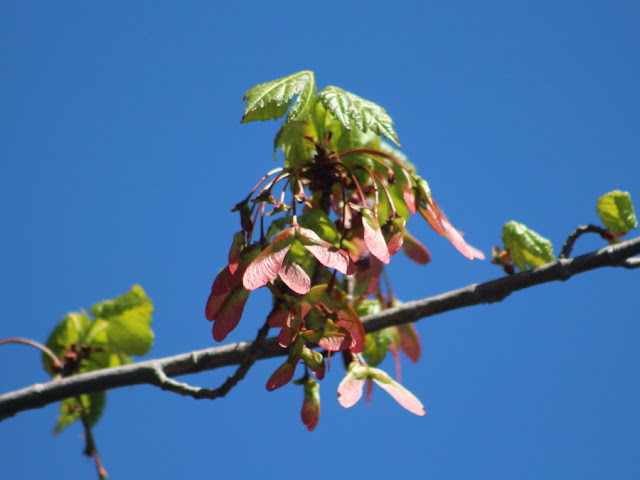 |
| New maple leaves with "noses" getting ready to helicopter away to find a place to grow. |
I always wonder why the largest plants - say the mighty oak - have such tiny flowers while a small plant like a trillium has blooms so much larger. I figure it's because a trillium has only flower, so it better be a good one, while the oak has so many it's sure to get plenty of pollen distributed, to which my itchy eyes and runny nose can attest.
 |
| That's a lot of pollen in all those flowers. |
I had a couple of peaceful paddles around Lake Wicwas this week, including a trip to Turtle Island to check on the re-vegetation project there to address the erosion of the thin soil on the island. We are making progress, though the snapping turtles are doing their best to thwart the effort.
 |
| Excavated snapping turtle nests. |
 |
| Leathery turtle shell fragments. |
.
On my way to Turtle Island I heard the unmistakable thwack of a pileated woodpecker hacking away at a tree. It was so loud it sounded like someone was cutting down a tree with a hatchet, which made it easy to locate the lumberjack. It was working on a medium size tree not far from the shoreline and it gave me a good show as I paddled by.
 |
| A Pileated Woodpecker doing its own excavating. |
A couple of other birds I found on my travel (in addition to the loons, of which we still have just the one pair) include a turkey vulture soaring over head and a Veery (May 25th correction) collecting food at the water's edge.
 |
| Turkey Vulture |
 |
Yes, I saw geese too, and they have goslings already. I'll keep an out for the little guys - they are so cute when they are small, yellow, and fuzzy.
There are also pretty trees to note on your travels around the lake; the downy service berry seemed quite prolific in their blossoms this year.
 |
| Serviceberry or shadbush |
And then there is this interesting plant on Bryant Island, which to the best of my ability to identify is a staghorn sumac.
 |
| Staghorn Sumac (Rhus typhina) |
.
If that's what this is, I think these are the fruits which grew last year; they're called drupes and contain the fruit covered with fine hairs. The fruit matures in autumn and remains attached through the winter. Staghorn sumac gets its name from the velvet covering on the twigs which makes it look like deer antlers, though it didn't fool the resident spider. [Ref: Eastern Forests, Ann Sutton and Myron Sutton, 1985, Alfred A, Knopf] According to that reference, the Indians made a "lemonadelike drink from the crushed fruit of this and related species."
The early summer weather makes it easy for people to forget that winter was here just two weeks ago. I took a hike up in the white mountains this week where there is still up to four feet of snow at the higher elevations.
 |
| The Crawford Path between Mt. Eisenshower and Mt. Pierce in the Presidential Range |
Packing spikes and snowshoes for a hike in 80 degree weather seems crazy, but there were people up there that were unprepared for what they encountered.
You know you're in a pretty special place when you can go snowshoeing at 80 degrees.
 |
| The summit of Mt. Washington seen through the spruce trees at about 4200'. |
No comments:
Post a Comment